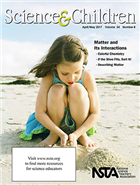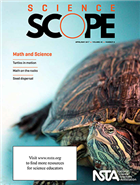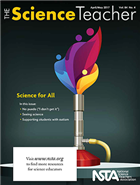Ideas and inspiration from NSTA’s April 2017 K-12 journals
By Mary Bigelow
Posted on 2017-04-25

Two articles of interest to all K-12 teachers:
- Commentary: The Importance of Cultivating Empathy in STEM from Science Scope, discusses how students can understand how STEM-related issues can affect people and society.
- Eclipses Across the Curriculum in S&C has ideas for integrated lessons pertaining to the August 2017 event.
Science & Children – Matter and Its Interactions
Feature articles in this issue focus on how to introduce young students to the characteristics and properties of matter and Small Pieces of Matter. The lessons described in the articles include connections with the NGSS.
- The activities described in Clean It Up! introduce students to “properties” of matter and how properties can be used to design procedures to separate mixtures.
- Using color and pigments as a context, Colorful Chemistry describes how students investigate how mixing materials can result in a chemical reaction. Artwork is part of the assessment!
- Are Clouds a Solid, Liquid, or Gas? addresses misconceptions students may have about the composition of clouds and the water cycle.
- If the Shoe Fits, Sort It! incorporates a tradition “sorting” activity of students’ shoes into a more robust study of organization, patterns, and characteristics. Can the shoes get back to their original owners?
- Describing Matter has a 5E lesson incorporating and app and hands-on experiences to extend student’s understanding of the properties of matter.
- Rethink the baking soda-vinegar “volcano” into a more accurate study of matter and mixtures with the lesson in The Early Years: Mixing Materials.
- Poetry of Science: What’s the Matter? includes a poem that reinforces the states of matter.
- Teaching Through Trade Books: Matter All Around Us provides developmentally appropriate 5E lessons for K-2 and 3-5 that focus on observable properties of matter.
- Methods and Strategies: Much Ado About Nothing describes the ideas and experiences young students have about the small-particle model of matter.
For more on the content that provides a context for projects and strategies described in this issue, see the SciLinks topics Chemical Reactions, Classification, Clouds, Matter, Mixtures, pH Scale, States of Matter, Water Cycle
Continue for Science Scope and The Science Teacher.
 Science Scope – Math and Science
Science Scope – Math and Science
“Why are we doing math in science class?” my students would ask. But they soon realized that math could be applied to other subject areas such as science, especially in terms of measurement, graphing, and data analysis. As the Editor notes, two of the NGSS science and engineering practices are related to math. The featured articles this month encourage this relationship.
Articles in this issue that describe lessons include a helpful sidebar (“At a Glance”) documenting the big idea, essential pre-knowledge, time, and cost. The lessons also include connections with the NGSS.
- Beat the Heat! An Investigation Into Heat Transfer, Cooling Capacities, and Dilution has suggested activities and graphing examples for comparing ice and rocks as cooling agents.
- With the investigation in Beluga Whales: Hyphothesis Generation and Evaluation students use mathematics and data to support claims in the context of studying whale vocalizations.
- The 5E lesson in Go, Turtle, Go: Measuring Motion to Build Proficiency in Science guide students to an understanding of motion, forces, and displacement. The article includes example of students’ graphs.
- A data collection is most useful when it is shared and accessible. Using Google Forms to Collect and Analyze Data describes a lesson in which students use technology to share and analyze data.
- The 5E lesson Using Math to Support Claims About Wind-Dispersed Seeds goes beyond observing and describing seeds to designing, testing, and analyzing plant adaptations for spreading seeds.
- Data collection and statistical analysis are math applications with relevance to science investigations. An Inquiry-Based Activity to Show the Importance of Sample Size and Random Sampling provides this first-hand experience.
- It All Adds Up: Wildcam Gorongosa Citizen Science describes an effort to construct a database of organisms in the park by analyzing images from wildlife cams. There are additional resources to use in the classroom.
- Students explore the concept of density and use measuring practices in Disequilibrium: Layered Liquids, a 5E lesson.
- Teachers share ideas Ways to Increase Math Confidence in Science Class in this summary from the NSTA listservs.
- The author of Analyzing Data With Mean Absolute Deviation provides an example of an investigation that emphasizes the importance of multiple trials in an investigation and how to analyze the data in a student-friendly manner.
For more on the content that provides a context for projects and strategies described in this issue, see the SciLinks topics Animal Behavior, Biodiversity, Density, Forces and Motion, Heat Transfer, Law of Conservation of Energy, Math and Science, Seeds, Temperature and Heat, Velocity, Whales
 The Science Teacher – Science for All
The Science Teacher – Science for All
TST’s Editor this month quotes NSTA’s position on multicultural science education and notes “In our diverse classrooms, we must champion ideals of inclusion and allow all people to feel valued and safe.” This month’s issue has featured articles with ideas to deal with the differences in ethnicity, socioeconomic status, gender, physical disabilities, learning differences, and various levels of English proficiency in our classrooms.
The lessons described in the articles include connections with the NGSS.
- Students who use a combination of Spanish and English have challenges in the classroom learning vocabulary and communicating. No Puedo has background information on “Spanglish” and describes a process to support them.
- More students with Autism Spectrum Disorders are in our classrooms. The authors of Supporting Students With Autism share strategies for capitalizing on their strengths (e.g., peer support, schedules, visual supports) and include ways to adapt lesson plans with accommodations.
- Many of the resources for teaching and learning science are highly visual. Seeing Science has ideas (including assistive technologies and other accommodations) to help students with visual impairments conduct investigations.
- The Science Standards and Students of Color shows how four classroom strategies (described in the NGSS) can help students: culturally relevant pedagogy, community involvement, multimodal experiences, and mentoring.
- What better way to involve students than to have them teach others? High school Students as Environmental Educators share their interest and enthusiasm with preschool students
- Commentary: Going Beyond the Textbook includes a discussion and references to help students make connections between science learning and their own experiences and cultures.
- Giving students choices of media to communicate what they learn is a way to accommodate students who have various interests. Science 2.0: Communicating Science Creatively describes some options.
- Animals and plants don’t understand or recognize political borders. The Green Room: How Border Walls Affect Wildlife discusses some activities for students.
For more on the content that provides a context for projects and strategies described in this issue, see the SciLinks topics Biodiversity, Biomolecules, Conservation of Matter, Invasive Species, Matter and Energy, Nutrition, Water Pollution, Watersheds, Worms
Disclaimer: The views expressed in this blog post are those of the author(s) and do not necessarily reflect the official position of the National Science Teaching Association (NSTA).

